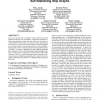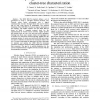552 search results - page 73 / 111 » Routing complexity of faulty networks |
PODC
2009
ACM
14 years 8 months ago
2009
ACM
Peer-to-peer systems rely on scalable overlay networks that enable efficient routing between its members. Hypercubic topologies facilitate such operations while each node only nee...
PERCOM
2008
ACM
14 years 7 months ago
2008
ACM
The IEEE 802.15.4 standard defines a set of procedures to set-up a Low-Rate Wireless Personal Area Network where nodes self-organize into a logical communication structure through ...
MSWIM
2004
ACM
14 years 1 months ago
2004
ACM
All analytical and simulation research on ad hoc wireless networks must necessarily model radio propagation using simplifying assumptions. Although it is tempting to assume that a...
DBISP2P
2004
Springer
14 years 1 months ago
2004
Springer
Today, there is an increasing demand to share data with complex data types (e.g., multi-dimensional) over large numbers of data sources. One of the key challenges is sharing these ...
TPDS
2010
13 years 6 months ago
2010
—A recursive multi-hop area hierarchy has a number of applications in wireless sensor networks, the most common being scalable point-to-point routing, so-called hierarchical rout...


